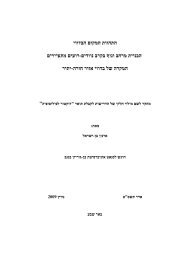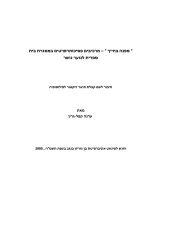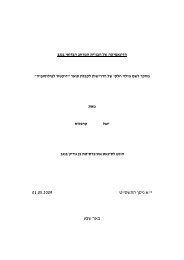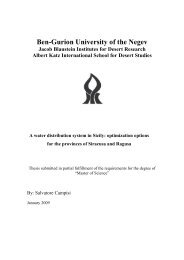CHARACTERIZATION OF DESERT DATE (Balanites aegyptiaca)
CHARACTERIZATION OF DESERT DATE (Balanites aegyptiaca)
CHARACTERIZATION OF DESERT DATE (Balanites aegyptiaca)
Create successful ePaper yourself
Turn your PDF publications into a flip-book with our unique Google optimized e-Paper software.
Figure 2.3d shows the negative-mode MS 2 fragment ions of the parent ion at m/z 1209.<br />
The major fragment ion peaks observed in this precursor ion are at m/z 1077, 1063, 915,<br />
769, 589, and 431. The mass differences between the parent ion at m/z 1209 and the<br />
fragment ions at m/z 1077 and m/z 1063 are 132 Da and 146 Da. This shows the loss of a<br />
pentose (xylose) and a deoxyhexose (rhamnose). This also suggests that there are two such<br />
sugars in the terminal residue of the saccharidic chain. However, the high intensity of the<br />
1077 ion indicates that first expulsion of xylose unit from the parent ion at m/z 1209. The<br />
fragment ions from m/z 1077 to 431, inclusive, give the same pattern of sugar-unit loss as<br />
the previous ion 1077 (Fig 2.3c). This suggests that this saponin peak is a very similar<br />
saponin to that of the main MW 1064, with an additional xylose and methyl unit.<br />
The [M-H] - ion MS 2 spectra of the peak ion at m/z 1045 is presented in Figure 2.3e.<br />
These spectra show that there are two main cleavages from the parent ion, at m/z 901 and at<br />
m/z 883, with a deletion of 144 and 162 Da from the parent ion, respectively. The intensity<br />
of the peak at m/z 883 is much greater than that at m/z 901, which demonstrates that the [M-<br />
H] - parent ion at m/z 1045 preferentially jettisons a 162-unit glucoside (glucose). The next<br />
fragment ion, at m/z 737, shows a loss of 162 Da (glucose) plus a loss of 146 Da<br />
(rhamnose) from the parent ion. The fragment ion at m/z 593 shows a further loss of 144<br />
Da. This is 2 Da smaller than a rhamnose molecule and thus is not rhamnose. The<br />
elimination of 144 Da, corresponding to cleavage of the E-ring, is generally observed in<br />
furostanol saponins. Such a cleavage phenomenon has also already been reported by Liang<br />
et al. (2002) and Liu et al. (2004) in a furostanol saponin of Asparagus cochinchinensis.<br />
Thus, this fragmentation pathway suggests that this peak is a genuine furostanol saponin.<br />
The smallest fragment ion, at m/z 431, shows further elimination of a glucose unit (162 Da)<br />
from the fragment ion at m/z 593. As with most of the other parent ions, this ion (m/z 1045)<br />
could not expel a sequential glucoside to produce the [Aglycone-H2O] - ion (m/z 413).<br />
Actually, LC-ESI-MS analysis of the methanol extract of B. <strong>aegyptiaca</strong> mesocarp<br />
produced eight peaks (Figure 2.1a). Among these eight peaks, we have discussed the<br />
MS/MS analysis of the five major peaks—in terms of area—at 4.2 (m/z 1195), 4.8 (m/z<br />
1063), 7.2 (m/z 1209), 8.2 (m/z 1077), and 12.4 (m/z 1045) min retention time. The other<br />
three peaks, at 6.0, 9.6, and 11.1 min retention time, repeat the values of m/z 1077 and<br />
27

















